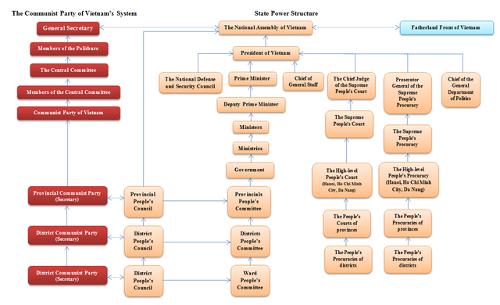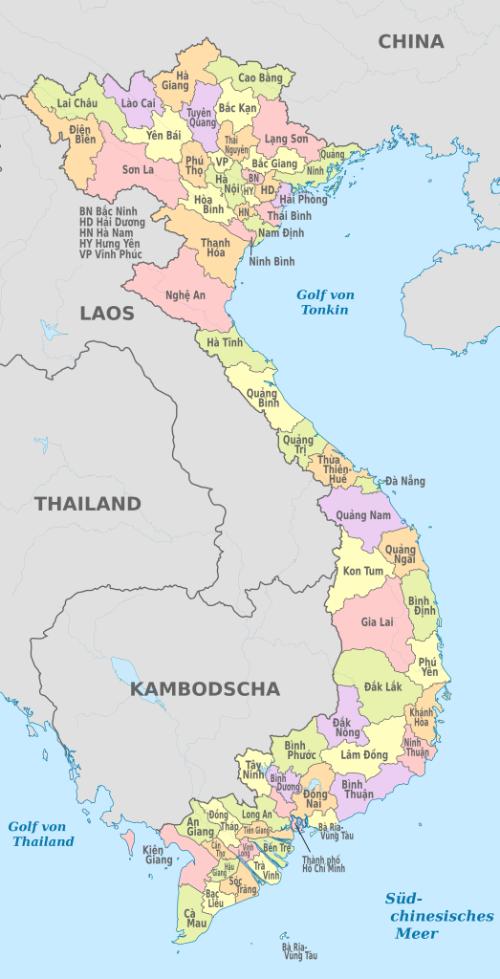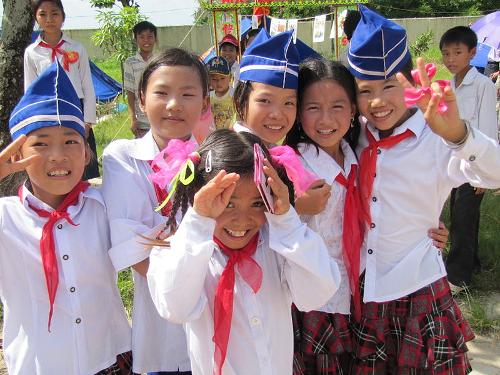VIETNAM
Society

Society
Cities in VIETNAM
| Hanoi |
Society
State structure
 Political Structure of VietnamPhoto: Trangtranmy CC 4.0 International no changes made
Political Structure of VietnamPhoto: Trangtranmy CC 4.0 International no changes made
Vietnam is a one-party state. After the reunification of North and South Vietnam in 1975, the Communist Party (CP) is the only allowed party, thus dominating political life. There are inevitably close links between the Party and the civil service. The main political body of the Communist Party is the Politburo, which has 19 members. It can issue decrees that in fact have the status of law. Yet the power of the Politburo has declined sharply in recent years.
A "balancing act" has emerged, as it were, between Party, government and parliament. Politburo members are elected from parliament, the 450-member National Assembly ("Quoc Hoi"), which meets twice a year and is elected for a five-year term. The candidates of the National Assembly are nominated by the mass organizations and elected in "free elections". Every Vietnamese belongs to and of the mass organizations: man, woman, youth, farmer, worker, intellectual, civil servant.
Until recently, the task of the National Assembly was limited to approving legislation initiated by the Party and the Politburo, but it now plays an increasingly important role in Vietnamese politics. For example, it has the right to appoint and dismiss the president, the vice president, the prime minister and the deputy prime ministers. An important task is also the appointment of ministers and chairmen of state councils, who are usually members of the CP.
Day-to-day management is in the hands of a government (State Council) consisting of the Prime Minister, Deputy Prime Ministers, a Council of Ministers and other members. The head of state is the president, who is elected by and from the members of the National Assembly, to whom he is also accountable. The president's term of office is five years and he is, among other things, Commander in Chief of the Armed Forces.
Part of the decision-making is decentralized to provinces, districts and communes. Local government (People's Committees) plays a very important role at these levels.
Vietnam is divided into more than 50 provinces ("tinh"); the urban areas of Hanoi, Haiphong and Ho Chi Minh City are under the direct authority of the central government. For the current political situation see chapter history.
Administrative division
 Vietnam administrative divisionPhoto:TUBS CC 3.0 Unported no changes made
Vietnam administrative divisionPhoto:TUBS CC 3.0 Unported no changes made
| province | capital | population | area |
| An Giang | Long Xuyen | 1.933.000 | 3.424 km2 |
| Bac Can | Bac Can | 240.000 | 4.796 km2 |
| Bac Giang | Bac Giang | 1.380.000 | 3.817 km2 |
| Bac Lieu | Bac Lieu | 722.000 | 2.485 km2 |
| Bac Ninh | Bac Ninh | 885.000 | 797 km2 |
| Ba Ria-Vung Tau | Vung Tau | 660.000 | 1.957 km2 |
| Ben Tre | Ben Tre | 1.310.000 | 2.247 km2 |
| Binh Dinh | Oui Nhon | 1.375.000 | 6.076 km2 |
| Binh Duong | Thu Dau Mhot | 595.000 | 2.718 km2 |
| Binh Phuoc | Dong Phu | 490.000 | 6.814 km2 |
| Binh Thuan | Phan Thiet | 860.000 | 7.992 km2 |
| Ca Mau | Ca Mau | 1.000.000 | 5.204 km2 |
| Can Tho | Can Tho | 1.782.000 | 2.951 km2 |
| Cao Bang | Cao Bang | 626.000 | 8.445 km2 |
| Dac Lac | Buon Ma Thuot | 1.175.000 | 19.800 km2 |
| Da Nang | Da Nang | 627.000 | 942 km2 |
| Dong Nai | Bien Hoa | 1.765.000 | 5.864 km2 |
| Dong Thap | Sa Dec | 1.465.000 | 3.276 km2 |
| Gia Lai | Pleiku | 740.000 | 15.662 km2 |
| Ha Giang | Ha Giang | 521.000 | 7.831 km2 |
| Hai Duong | Hai Duong | 1.625.000 | 1.661 km2 |
| Ha Nam | Ha Nam | 775.000 | 827 km2 |
| Ha Tav | Ha Dong | 2.230.000 | 2.147 km2 |
| Ha Tinh | Ha Tinh | 1.295.000 | 6.054 km2 |
| Hoa Binh | Hoa Binh | 715.000 | 1.780 km2 |
| Hung Yen | Hung Yen | 1.040.000 | 895 km2 |
| Khanh Hoa | Nha Trang | 925.000 | 5.258 km2 |
| Kien Giang | Rach Gia | 1.330.000 | 6.243 km2 |
| Kon Tum | Kon Tum | 250.000 | 9.934 km2 |
| Lai Chau | Lai Chau | 505.000 | 17.131 km2 |
| Lam Dong | Da Lat | 745.000 | 10.173 km2 |
| Lang Son | Lang Son | 675.000 | 8.187 km2 |
| Lao Cai | Lao Cai | 540.000 | 8.050 km2 |
| Long An | Tan An | 1.230.000 | 4.338 km2 |
| Nam Dinh | Nam Dinh | 1.820.000 | 1.669 km2 |
| Nghe An | Vinh | 2.685.000 | 16.381 km2 |
| Ninh Binh | Ninh Binh | 840.000 | 1.388 km2 |
| Ninh Thuan | Phan Rang-Thap Cham | 450.000 | 3.430 km2 |
| Phu Tho | Phu Tho | 1.195.000 | 3.465 km2 |
| Phu Yen | Tuv Hoa | 710.000 | 5.278 km2 |
| Ouang Binh | Dong Hoi | 740.000 | 7.984 km2 |
| Ouang Nam | Tam Ky, Hoi An | 1.290.000 | 10.406 km2 |
| Ouang Ngai | Ouang Ngai | 1.150.000 | 5.856 km2 |
| Ouang Ninh | Hong Gai | 890.000 | 5.939 km2 |
| Ouang Tri | Dong Ha | 521.000 | 4.592 km2 |
| Soc Trang | Soc Trang | 1.175.000 | 3.191 km2 |
| Son La | Son La | 780.000 | 14.210 km2 |
| Tav Ninh | Tav Ninh | 870.000 | 4.020 km2 |
| Thai Binh | Thai Binh | 1.770.000 | 1.509 km2 |
| Thai Nguyen | Song Cong | 907.000 | 3.541 km2 |
| Thanh Hoa | Thanh Hoa | 3.315.000 | 11.168 km2 |
| Thua Thien-Hue | Hué | 975.000 | 5.009 km2 |
| Tien Giang | My Tho | 1.625.000 | 2.339 km2 |
| Tra Vinh | Tra Vinh | 940.000 | 2.369 km2 |
| Tuven Ouang | Tuven Ouang | 630.000 | 5.801 km2 |
| Vinh Long | Vinh Long | 1.045.000 | 1.487 km2 |
| Vinh Phuc | Vinh Yen | 1.015.000 | 1.371 km2 |
| Yen Bai | Yen Bai | 640.000 | 6.808 km2 |
| urban area | capital | population | surface |
| Haiphong | Haiphong | 1.585.000 | 1.504 km2 |
| Hanoi | Hanoi | 2.160.000 | 921 km2 |
| Ho Chi Minh | Ho Chi Minh City | 4.330.000 | 2.090 km2 |
Education
 Vietnamese children in school uniformPhoto: EU Humanitarian Aid and Civil protection CC 2.0 no changes
Vietnamese children in school uniformPhoto: EU Humanitarian Aid and Civil protection CC 2.0 no changes
Education has always been important in Vietnam's history, especially inspired by the teachings of Confucius. Compared to other developing countries, Vietnam has a fairly well-educated population and therefore only a relatively small part of the population is illiterate. Most illiterate people are found among the minorities.
Not so long ago, education was a fully state responsability. After the reunification of Vietnam, many private schools were established, especially in the south, in the context of Doi Moi.
Vietnam has compulsory education for children aged six to fifteen, and the majority of Vietnamese children (approx. 89%) attend primary school. Primary education has a lower school that lasts five years and a superstructure of four years. Because teachers are poorly trained and schools are struggling with a lack of furniture and books, the students actually learn far too little. Many children drop out after primary school, about a third of the children attend secondary education.
Secondary education lasts three years and can give access to a college or university. There are about a hundred institutes of higher education, with universities in Ho Chi Minh City, Hanoi, Cantho, Dalat and Hué. Haiphong has a Maritime Academy and Danang a Technical College.
The integrated education program has now been implemented in a total of 31 kindergartens and 32 primary schools. By 2000, 475 teachers had been trained in teaching children with disabilities, and more than 1000 disabled children were attending school.
Vietnam is facing a shortage of training places for higher education students. Of the 850,000 school-leavers, only 170,000 can follow further education. However, the training is often of a theoretical nature and by no means always meets the demand from the labor market.
Sources
Krücker, F.-J. / Vietnam
Elmar
Paulzen, H. / Vietnam : mensen, politiek, economie, cultuur, milieu
Koninklijk Instituut voor de Tropen
Peterse, L. / Vietnam
Gottmer/Becht
Te gast in Vietnam
Informatie Verre Reizen
Vietnam
Cambium
Vietnam
Lannoo
Wulf, A. / Vietnam
Het Spectrum
CIA - World Factbook
BBC - Country Profiles
Last updated November 2025Copyright: Team The World of Info